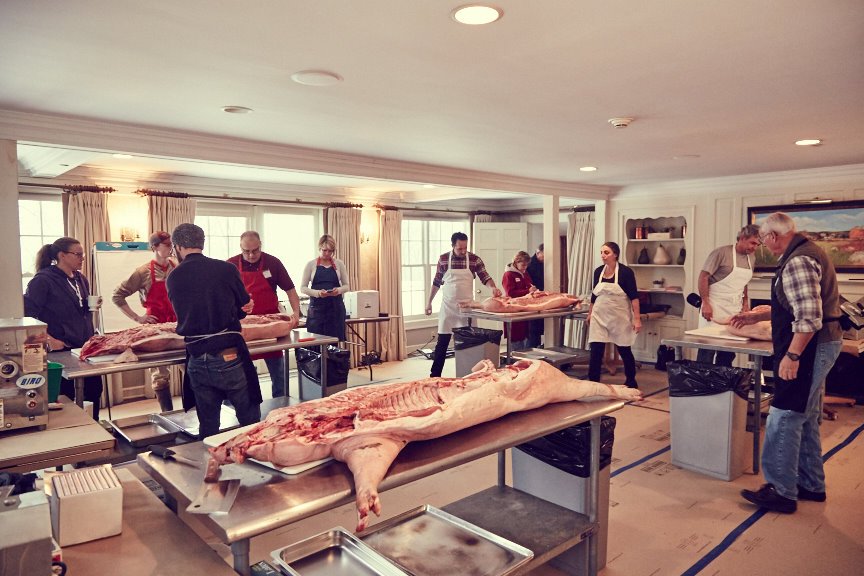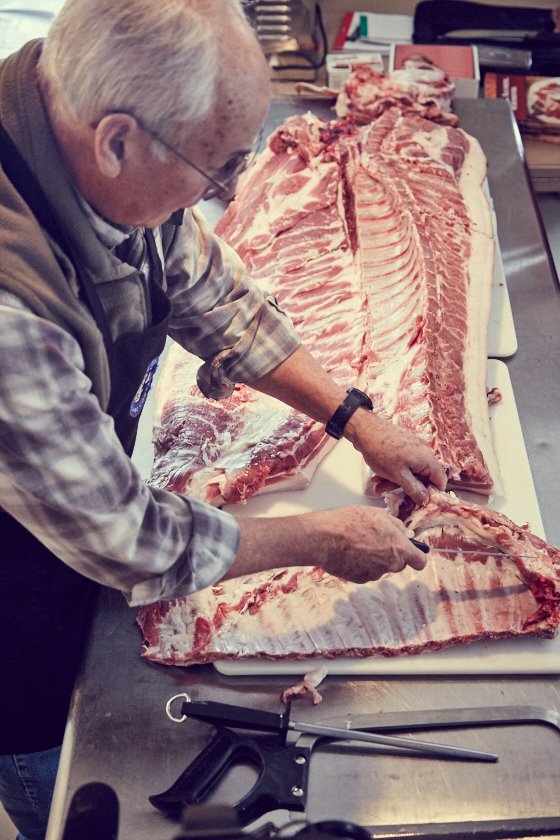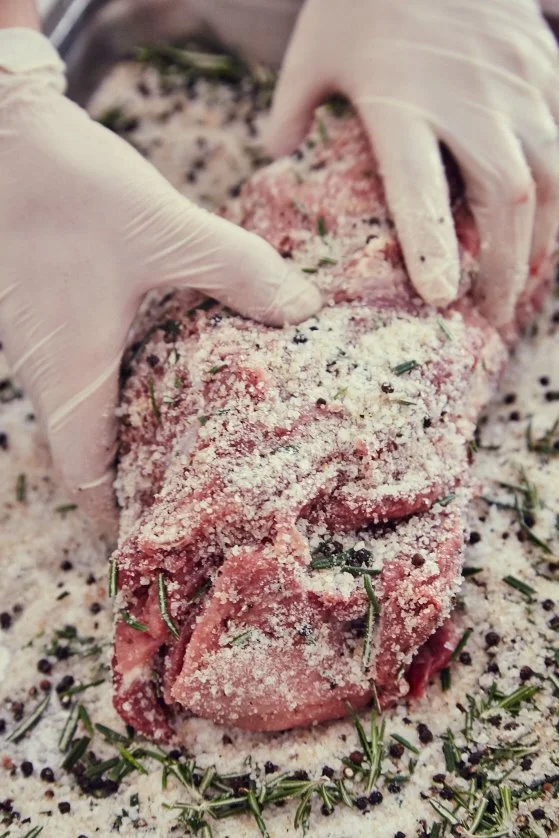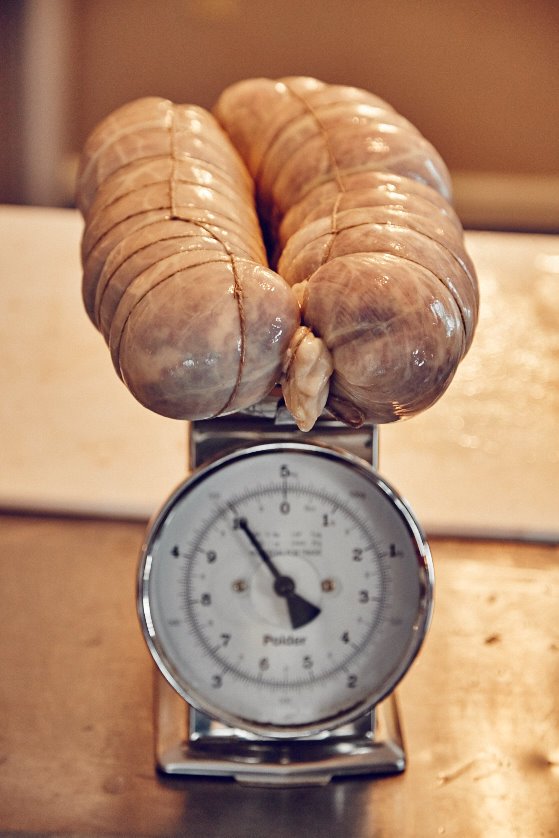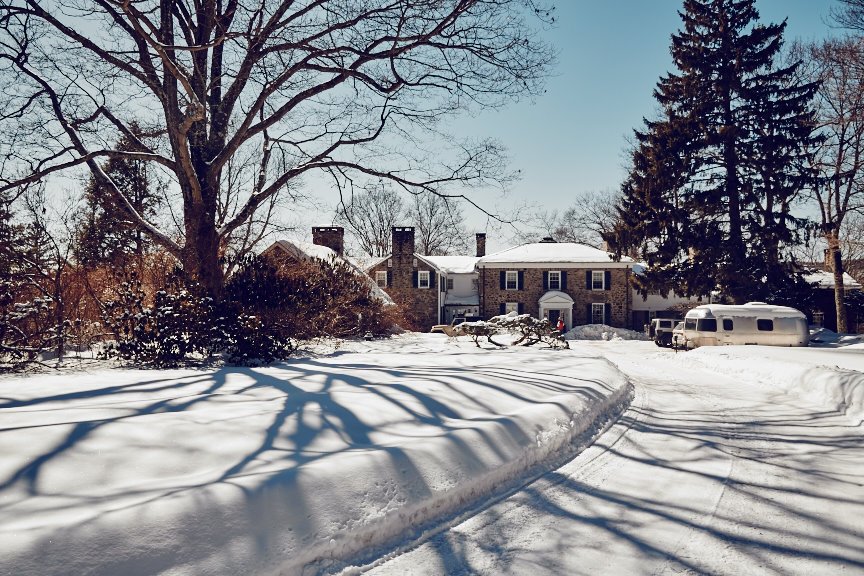Beast Masters
A gathering of charcuterie artisans
This story is featured in
Edible Hudson Valley Magazine & Copenhagen Food Magazine
Text and photo by Danny Christensen
The Hudson Valley is a natural incubator for top-quality food products. Its rich soil and balanced climate make the region ideal for crop and livestock production with a thriving food industry following in its wake—all just a little more than a stone’s throw away from one of the world’s top culinary hot spots: New York City. Sara Grady, vice president of programs at Glynwood in Cold Spring, sees amazing potential in her home region of the Hudson Valley and with all the valley’s small farms and food producers—especially the rapidly growing charcuterie industry. For the uninitiated, “charcuterie” is an umbrella term referring to any number of cured, salted or smoked meats. In French, the word “charcuterie” translates roughly to “cooked meat,” but the “cooking” is achieved through any number of labor-intensive processes and was historically intended as a means to preserve meat, in many cases elevating inferior cuts that would otherwise go unappreciated. If you have ever had bacon, sausage or salumi, you have enjoyed charcuterie, and the same goes for the more rarefied duck rillettes, pâtés and head cheese.
Beyond labor intensive, charcuterie production is often a formidable task as clearing the many legal hurdles can make the endeavor a less-than-profitable venture. Grady, who along with Glynwood helped to initiate the Cider Project in 2010, which greatly promoted the local craft cider movement, also sees, hears and feels many of the challenges the valley’s small producers of charcuterie, or charcutiers, are faced with daily, dragging a heavy, confusing and tight-knit net of financial, infrastructural and regulatory challenges behind them. This net sometimes stops, or at least slows down, the huge potential clearly present in the hearts and souls of the valley.
This past spring, with the intention of bolstering and sustaining the growing population of charcuterie producers, Glynwood arranged a special invite-only five-day charcuterie and salami workshop with François Vecchio, a grandmaster charcutier with more than 60 years of experience in the traditional European craft of charcuterie and salami from Italy, France and Switzerland who now calls California home base.
Vecchio is a seasoned charcuterie expert who believes in traditions, natural processes and, above all, craftsmanship. By marrying Vecchio’s knowledge and the abundance of quality-focused small producers in the region, Glynwood set the framework for a week where local producers were able to look back and reflect on traditions and history to build a strong foundation for the future of the small farms, food and charcuterie producers of our beloved region.
A butcher at rest: Francois Vecchio takes a moment before more carving and crafting.
MEAT AND GREET
The art and craft of charcuterie dates back some 6,000 years. Originally it was developed out of the utter necessity to preserve food and prevent it from spoiling, as charcuterie may not have been so much the thing you put out on your cheeseboard for dinner guests, but the food stuff that got you through a rough and meager winter.
Current European curing methods and meat products are often near identical to those from the 15th century, unchanged by time. Today you can walk into any European grocery store and buy a product that is made the same way, with the same recipe and ingredients used in Renaissance-era Europe.
That would not be possible in the U.S.—unfortunately, the rules and regulations imposed by the USDA prohibit most of the traditional production and handling methods when working with aged meat, with the concern that a miscalculation or a bit of carelessness with the preparation can often produce disastrous results.
For this past spring’s workshop, participants were settled in at one of four designated workstations at Glynwood, where for the sake of the workshop and the greater good of the Hudson Valley, the main dining room was turned into a charcuterie and meat production facility. (Not USDA approved, but carefully and meticulously maintained). The chatter and noise go quiet as the halved pigs from Raven & Boar farm in East Chatham and Flying Pigs Farm in Shushan enter the room heaved onto the respective shoulders of Paul Wetzel from Gramercy Tavern and Ruby Duke from Raven & Boar.
The avuncular Vecchio enters the room while drying his hands off after washing. He calls for everyone to gather around Workstation 1 and the displayed halved pig, split right down the middle from spine to belly, snout to tail.
Jack Peele of JACüTERIE prepping for the sausage.
You invest in educating a butcher to use a knife and not power tools, to savor the high-quality and most profitable meat parts, and you will end up with a higher-quality product, higher-profit cuts and much lower overall loss on the pound.
Most people would likely be taken aback at the sight of an animal displayed like that, but not this assemblage. Gathering around the freshly slaughtered pig are a diverse group of handpicked producers from the Hudson Valley—from farmers, slaughterhouses and meat producers to charcutiers and chefs.
Vecchio addresses the group and task at hand by saying, “This is a nice pig. Good-quality meat, good-quality fat. It’s all about the quality!”
He checks the meat and the fat by testing the firmness with his thumb and then proceeds to closely inspect the color and marbling of the meat. With a confirming nod, he again repeats, “It’s a good pig—good quality. We can make everything with this pig.”
Within the marbling of that dry statement lies the somewhat complicated solution and the very key to prolonged success in the world of charcuterie: You need good quality. You need to have the knowledge of what good-quality meat looks, feels and tastes like. You need to buy into and commit to quality from the start.
Good-quality meat comes from happy and stress-free animals that are nurtured and cared for—meat that is becoming more and more the norm in local farms. The animals need an environment as close to their natural habitat as possible, where they have shelter, space to roam and a varied diet.
We plant and rotate forest crops so the pigs gets a varied diet,” say Duke from Raven & Boar, a farm covered in this magazine (Summer 2013 issue) and known for their heritage-breed pork. From day one Raven & Boar has been committed to animal welfare, sustainable farming and quality.
Some businesses-minded skeptics insist that it’s impossible to commit to such essential parameters in a pressed and tight market, but as Michael Rizzy from Flying Pigs Farm has proved, attention to and focus on quality can be profitable and can downright secure the reputation of a budding farm business. Flying Pigs Farm went from producing just three pigs at their start in 2000 to producing over a thousand in 2014, and Rizzy’s unwavering devotion to the philosophy is what continues to fuel his farm’s success.
With direct farm-to-consumer food sales accounting for merely 1 percent of overall U.S. consumption and 80 to 90 percent of meats being produced by five meat processing companies, there is a long way to go, and the small producers are pressed enormously on price. “Quality speaks to a feeling; quantity speaks to numbers,” says Vecchio.
But there’s a lot to be said about quality and numbers. Today, industrial slaughtering, even small-scale, yields a loss of 20 to 30 percent on the slaughtered weight. That’s a huge loss in weight and money, not to mention the environmental impact. Compare that to most small producers in the area that have adopted the age-old ethos of waste nothing and allow creativity and craftsmanship to literally preserve the harvest.
Ruby Duke of Raven & Boar bringing in the fresh kill.
CUTTING
Sounds of steel on steel fill the room with philharmonic-like elegance as the edge of the knife graces the honing steel.
“Let’s break down this pig and dedicate the cuts to different products,” Vecchio says. He turns to Richard Beckwith, owner of Hill Town Pork in Canaan, and asks him to demonstrate how he as a butcher would process the animal.
Beckwith, a very knowledgeable and experienced butcher, puts the knife to the flesh. Vecchio silently observes for a bit but then stops Beckwith.
“This is a very standard way of butchering a pig in the U.S., where volume speaks numbers,” he says. It’s a somewhat bold, and almost accusatory, statement from the charcuterie master.
Normally in the world of charcuterie, there are three quality groups of meat, each one best suited for different kinds of charcuterie and salami products. Quality one is the best and most expensive, and quality three is, naturally, of the poorest quality and the least expensive. “With the traditional U.S. way of butchering, with focus on quantity and time, you’ll end up with much more quality two and three meat that pays much less and you’ll have a very high loss percentage,” Vecchio explains.
It all comes down to that principle of quality, and investing in and educating butchers, producers and consumers on knowing the difference and how to identify it. “You invest in educating a butcher to use a knife and not power tools, to savor the high-quality and most profitable meat parts, and you will end up with a higher-quality product, higher-profit cuts and much lower overall loss on the pound,” Vecchio explains.
Now, that is a gospel that has the entire room lighting up and nodding in agreement.
The potential for the small farms and producers of the Hudson Valley to rise to the top of the New York culinary scene is evident and seemingly imminent, even to a seasoned European charcuterie master. “You have a unique opportunity here. You are small producers right outside one of the world’s culinary hot spots with an enormous consumption of high-quality food products, so you can make a difference and you can secure your product’s room on the plate of millions of consumers if you do it right,” Vecchio advises the group. He’s right, but it’s not that easy. There are many challenges. Many of those challenges motivated Grady to arrange this workshop and invite key epicurean players from the valley.
Some of the biggest challenges for the region’s small producers are the regulations and bureaucracy of the USDA. As noted earlier, not all charcuterie is created equal—and as Vecchio explains, it becomes clear that the USDA, armed with money and influence, navigates and dictates the rules and regulations imposed on the culinary souls of our valley as well as mega-operators. While safety predominates when it comes to USDA regulation, the USDA tends to smile a bit more broadly on larger operations than on the smaller independent producer.
“The USDA rules and regulations favor factory farming and quantity, not small farms, small producers and quality,” says Vecchio. “The world of the USDA is simply too sterile; it’s upside down. You deplete the products of bacteria—the same bacteria that give the meats and products their unique flavor. You deplete our immune system of these bacteria that help build our immune system.”
Vecchio is clearly fired up about the issue, and everyone present seems to see the truth in his words.
Bacteria lives all around, on and in us. It’s a part of us, not something that needs to be eliminated from our world and wiped away with chlorine bleach. But to be sure, it is a delicate balance, and when producing any sort of preserved meat product, or any food product for that matter, food safety should never be something served hastily or haphazardly.
However, take a look at Vecchio: He’s well into his 70s, and he’s eaten more charcuterie and bacteria than most people. His method of taste and quality control is sticking his finger into everything—from raw blood to raw salami meats—and tasting it. Not likely a technique that would please USDA inspectors, but it seems to work for him. It’s all in education and, of course, regulations.
The workshop with Vecchio proved enlightening for many of the local producers. “This week at Glynwood has taught me so many small details and methods that I’ve never read or heard about. I taught myself to make charcuterie and salami—learning from Internet videos, books and finally a charcuterie class at the French Culinary Institute [now International Culinary Center]—but nothing taught me as much as I learned here at Glynwood from François,” says Jack Peele, owner of JACüTERIE, one of the valley’s passionate charcutier young bloods.
It again raises the question about history and tradition in respect to quality. The U.S. is a young country—the charcuterie and salami craftsmanship is new in comparison to the old European traditions. But in a respect, this opens up the market to all levels of experimentation and expression, as the U.S. is hardly bound to tradition as far as charcuterie is concerned.
Lacking an inherent tradition but armed with passion and drive for creation often leads to new and great things—and that may be the case for the charcuterie and salami production in the Hudson Valley. The region has some of the best-quality meats, the impetus to make something exceptional, the backing of institutions like Glynwood and now around 14 disciples who will help spread the gospel of charcuterie master François Vecchio—all with a strong stimulation to explore new heights.
The challenge speaks not only to the quality of the region’s products, but to the struggle and hurdles the producers are facing with the tight, un-nuanced USDA rules and regulations that often restrict their business opportunities to local and very limited sales.
Hopefully with the help of people like workshop attendee Mark Elia of Hudson Valley Sausage Company, who is also an instructor at the Culinary Institute of America, and with continued support from Cornell University and their Small Farms Program, and who knows, maybe even the USDA—the rules, codes and regulations will be adjusted and reconsidered to even out the playing field for large as well as small producers, moving the focus from factory farming to sustainable farming, animal output to animal welfare, and quantity to quality.
Industrial slaughtering, even small-scale, yields a loss of 20 to 30 percent on the slaughtered weight. That’s a huge loss in weight and money,
not to mention the environmental impact. Compare that to most small producers in the area that have adopted the age-old ethos of waste nothing and allow creativity and craftsmanship to literally preserve the harvest.
PRESERVED
After days where the wise words and gospel of charcuterie master Vecchio seemed to resonate with and impact even the strongest nonbelievers in the crowd, the discussion was often continued over dinner and local hard apple cider. At the end of the weeklong workshop, everyone seemed to leave with a sense of community and with the common goal to do better—to take our local industry to new heights.
And as Vecchio starts up his car for the return trip to California and attaches his Airstream trailer to the hitch, I wonder why he does this. Why would he drive across the country from sunny and warm California, where he settled down to retire, to what was then cold and snowy New York? He doesn’t need the money.
Well, probably because his presence was graciously requested by the Glynwood folks to enlighten an already budding scene. But more likely it was because Vecchio passionately believes in the art and craftsmanship of charcuterie and salami, and he believes in the potential and aspirations for the Hudson Valley and its many fine farms and producers to produce something that doesn’t so much approximate the European model but is an unique expression of this place and particular time.




